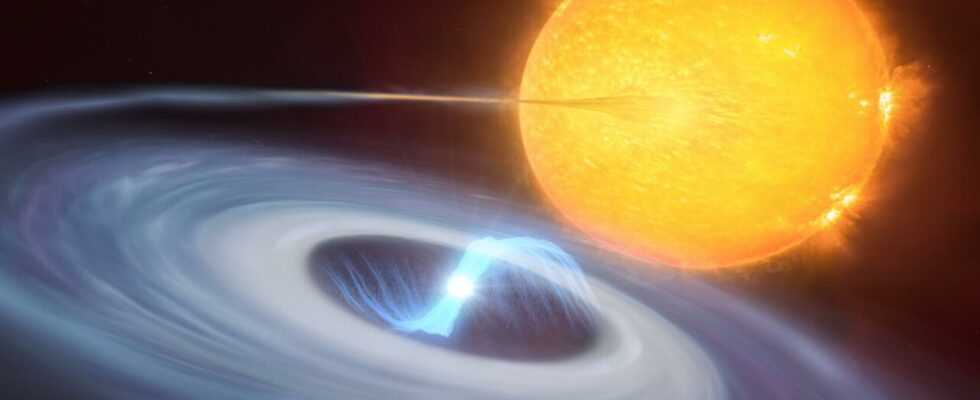For the first time, astronomers have discovered a micronova: star explosions a million times less powerful than the well-known supernovae. They are therefore more difficult to detect, but could be very numerous.
The supernova is a bit like the grand finale for a star. It is the fireworks display that occurs at the end of its “life”, when there are not enough elements left to produce the necessary nuclear fusion. All the atoms are then ejected in a gigantic shock wave. A discharge of energy such as the resulting light can remain visible for several months.
But researchers, who scanned the sky with the Very Large Telescope in Chile, witnessed another phenomenon similar to this one, but smaller. A shorter, more modest, more elusive explosion, which they named micronova. ” what we sawtells Numerama the main author of the discovery, Simone Scaringi, it’s a series of thermonuclear explosions on the surface of a white dwarf. The same phenomenon as supernovae, but smaller. »
The Durham University astronomer published his findings in a study that appeared in Nature on April 20, 2022. He is interested in TV Columbae, a binary system composed of a white dwarf (a “dead” star of which only the core remains) and a companion (certainly a star, but not identified). A system that has intrigued researchers for decades, since sudden energy emissions have often taken place there, and remained unexplained until then. Simone Scaringi specifies: “ What happens is that the white dwarf accretes the mass coming from its companion, which produces these explosions. But that’s not how it usually happens! »
Small localized explosions
White dwarfs are usually a little quieter. Some emit in X-rays, but it is rare to observe variations in luminosity, even less flashes thirty times brighter than the normal state of the star. What can happen, however, is that a white dwarf attracts enough material from its companion to grow. And when it reaches critical mass, it collapses in on itself, causing a Type Ia supernova, also called a thermonuclear supernova.
But that’s not what happens at TV Columbae. It accretes matter from its companion well, but instead of continuing to accumulate mass until it exceeds the limit, it produces smaller explosions on its surface which the team has therefore dubbed “micronova”. ” It was a real surpriserecognizes Simone Scaringi. Normally, these types of explosions do not occur on white dwarfs, and it took us a whole year to figure out what it was. »
Ironically, papers dating back to the early 1980s had already reported such localized events on white dwarfs, but explanations of the mechanisms taking place had not stood the test of time.
But why isn’t TV Columbae completely consumed? According to the authors, this could be due to hydrogen fusion. On a classic supernova, the hydrogen comes from the companion, it is attracted to the white dwarf, then arriving on the extremely hot surface, the atoms are excited, fuse to form helium, and explode. But some white dwarfs act differently. The strength of their magnetic field channels the hydrogen at the magnetic poles, as if the atoms were going through a funnel to come together at a single point. Thus, these areas are the only ones to be affected by the explosions. Instead of being completely consumed, the star only undergoes a few small blows, mini-thermonuclear explosions.
3.5 billion Pyramids of Giza every boom
That said, the explanation may so far suggest that these explosions are almost harmless. It must be remembered that all this happens on the surface of a star. Each of these booms is still enough to reduce a medium-sized asteroid to dust. In its press release, the ESO (European Southern Observatory) suggests that the phenomenon destroys each time the equivalent of 3.5 billion Pyramids of Giza. This corresponds more or less to one millionth of the mass of the Earth. Everyone is free to find a more meaningful comparison.

These explosions are therefore violent, but remain insignificant on the scale of the Universe and only last a few hours. They reveal phenomena hitherto unknown, but remain difficult to observe. Fortunately, now that astronomers know exactly what to watch for, they have a better chance of witnessing it. ” We have already found micronovae in three different systemsenthuses Simone Scaringi. And we have a fourth with very similar explosions. It’s a challenge, as it all comes and goes very quickly, but we’re confident we’ll find even more. »
For this, the team can count on the TESS telescope, which monitors a large part of the sky. It will then be necessary to observe these different phenomena on several wavelengths to understand exactly how the process works.
These micronovae are just one more line on the list of stellar explosions, but they are likely to be scrutinized closely in the years to come.
